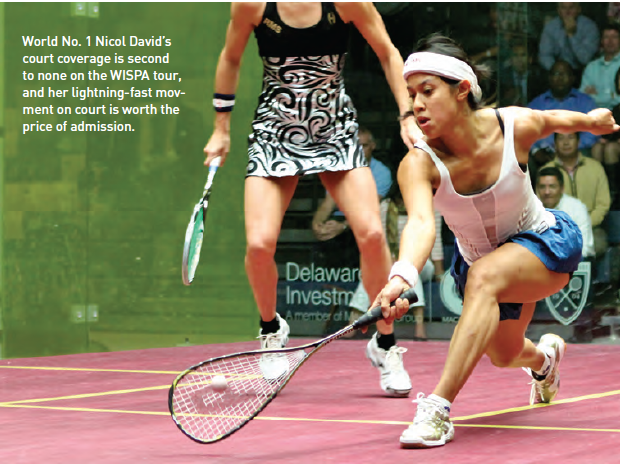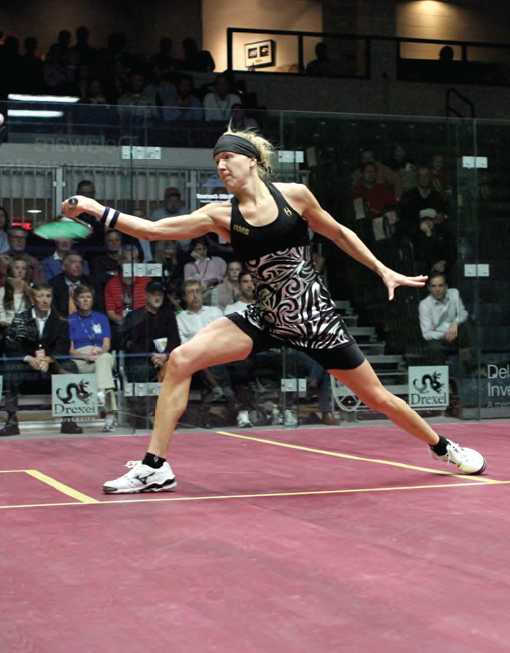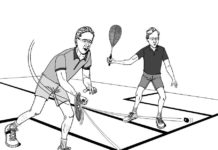By Tracy Gates
One of the most exciting points I watched during the U.S. Open Squash Championships last month was when Joelle King and Nicol David were trading drop shots and then King hit a hard left wall rail that powered the ball to the back of the court. As David was still crouched at the front of the court, it looked like a sure winner to me. Who could possibly get to a ball hit with such force from where she was on the court? And then I watched in total astonishment as David threw herself down the length of the wall, her racquet thrust in front of her.
David is not a tall player—unlike her gazelle-like opponent—but her body looks like that of a top-level gymnast, built to move in many directions. Being a bit smaller and lighter, it creates less wind resistance and better defies gravity, so enabling her speed-of-light movements around the court. Well, that last part may be a bit hyperbolic. . . but I’m at least willing to bet she practices zinging from one end of the court to the other in preparation for these very circumstances. And it was a fantastic feat to witness; I felt very lucky indeed to be sitting mere meters from the glass back wall of the court where I could see her expression change from zen-like concentration to bug-eyed uber focus. If one learns anything from this, it’s never ever ever take your eye off the the ball, because David did indeed get her racquet on it and got it back; it was truly amazing and she went on to win the point, the game, and the match 3-1.
But even more amazing, as I glanced around the few rows of bleacher seats behind the court, was how few eyes were on this fantastic match. Yes, it was standing-room only, but that meant maybe forty people max. And, yes, it was a first round match. But this was Nicol David, World No. 1, playing World No. 10! This was tippity-top squash! Where were the fans??

Oh, this is old news. It’s been written about, and just recently addressed in two online articles: A First Class US Open, But Where Were the Spectators? on DailySquashReport.com and then a rebuttal of sorts, No Shame Except in Shaming on SquashDashersandBashers. blogspot.com. In the first article, the author made us feel pretty sheepish that we hadn’t filled the stands every day, and in the second, the writer argued that the Open was too big for its britches and people shouldn’t be shamed for not attending. I can’t help seeing some truth in both sides of these arguments; if we love to play squash and want to see it flourish—even survive, dear god—then when there’s an opportunity to see the pros play, we should take it, if we can afford it. I’ve seen too many squash courts disappear in my city to believe that we can just stand by and play and expect that squash will continue merrily along without our helping it in any way we can. And yet, I also don’t want to feel shamed into doing so. I’d rather be persuaded.
I admit that I didn’t watch much squash until a few years ago when I started playing in New York Squash’s Grand Open Tournament, whose entry fee comes with early round tickets to the Tournament of Champions in Grand Central Terminal. At first, I enjoyed the spectacle of the venue and the camaraderie of the player-fans more than I could appreciate the far beyond- my-dreams level of play on the gleaming glass court itself. But the more pro-level squash I watch, the more the strategy, shot execution, and movement on court makes sense and the more it impacts my own game. While watching some of the women’s U.S. Open matches, I was cramming as many tidbits as I could into my memory for later use. Victoria Lust made a distinct impression as she twisted her torso back and up, in preparation for the powerful unwinding of her backhand, and I actually saw a difference in my own shots later that week. And Nicol David’s ability to speed up the pace of play, as well as Delia Arnold’s decision to slow it down, has shown me that braking and accelerating is as important to a game of squash as it is on the road. The more I watch squash, the more I think about squash, and as fun as it is to just play, squash is a thinking game.
So do I hope that more people will think more about supporting squash at all levels? Definitely. I think we’re missing out on such great opportunities, both for ourselves and for the greater squash community if we don’t—from playing in leagues and tournaments, to lending a hand helping out local squash associations and/or urban youth squash programs, to attending pro matches, perhaps with the students in these programs.
Selfishly, I may not want to give up my prime seat to watch the likes of Nicol David on an intimate college court, but her level of play deserves many more fans, in many more seats. We just have to persuade ourselves that we deserve to watch.
Tracy Gates watched the U.S. Open Squash Championships this past September. She wrote about it on her blog www.SqueakyFeet.wordpress.com.





